Zombie Survival Tip: Know Your Zombies
By Jade Greenberg, Zombologist
In the first part of the Zombie Survival Tips: Before the Apocalypse, I reviewed the types of zombies one is likely to encounter. In this second edition, I will take you through them in more detail. Reviewing the movies from the “See them in” sections will help you spot these types of zombies more quickly and be more familiar with their likely actions.
Shamblers
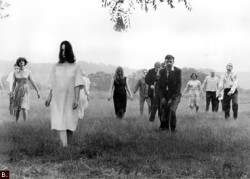
Shamblers from Night of the Livng Dead
Notable qualities: These slow moving, decomposing creatures reanimate after death … sometimes, long after (such as those that come through the ground in a graveyard). They have normal to slightly less than normal human strength, are displeasing to the olfactory sense (mostly due to being in the process of actually rotting), and typically eat their entire victim (not focusing on one particular area of the body).
See them in: Night of the Living Dead (1968), Dawn of the Dead (1978), Day of the Dead (1985), Land of the Dead (2005), Shaun of the Dead (2004), The Walking Dead (TV series)
Watch out for: The danger they pose. While one shambler is easily conquered without even the use of a gun (a cricket bat, machete, or ax will do the job), a herd of them can easily overpower a group of survivors if they are caught unaware. Shamblers, despite not being very intelligent, can sometimes still use basic tools.
To successfully combat shamblers, vigilance coupled with preparedness is more than half the battle.
Fast-movers
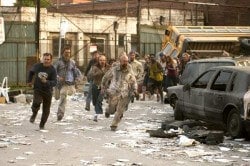
Fast movers from Dawn of the Dead
Notable qualities: This group of the undead is particularly dangerous because they are not only infectious, but they’re moving at or beyond normal human speed. Typically, this particular batch are the result of viruses (lab experiments gone wrong, or attempts at bioweaponry), and are more aggressive than their shambling counterparts.
See them in: the Resident Evil series, Dawn of the Dead (2004)
Watch out for: Any group that would want to create “super-soldiers.” Whether coming from the military or a corporation that values profit above ethics, the compounds that could create “super-soldiers” can easily create hard-to-kill zombies, instead. Similarly dangerous results can be produced due to attempts at creating bioweaponry or aerosolized distribution (of vaccines, viruses, or anything medical in nature).
Fast-movers are difficult to kill in close combat, and can easily overwhelm even a well-prepared, armed group. Killing these creatures is an activity best conducted from a distance and/or from inside vehicles (such as fortified buses, tanks, or helicopters).
Talkers
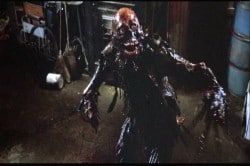
Return of the Living Dead talker zombies
Notable qualities: While most zombies are busy moaning, this particular sub-set speak. Some are more talkative (and intelligent) than others, a factor often influenced by the length of time the body has been in the state of death/undeath. Faster than shamblers, this group typically moves at typical human speed (sometimes slower, depending on injuries to the body) without having abnormal/accelerated velocity.
See them in: example: the Return of the Living Dead series
Watch out for: Chemicals, such as Return of the Living Dead’s Trioxin 2-4-5. These can appear in clearly ominous situations, such as in the basements of morgues and embalming facilities or in laboratories found on military compounds. However, they can also initially seem more benign (comparatively, at least, to a vat in a morgue), taking the form of new intoxicants (such as designer/club drugs). This type of chemical compound could also be delivered in the form of a new (not yet FDA-approved) medication or vaccination. Additionally, this type of zombie could be produced by a virus that continues working in the body after the subject dies, making actual death less evident until a lack of vital signs is confirmed.
Avoid engaging these creatures in conversation, as developing sympathy for them could result in putting oneself in danger. These zombies prove most dangerous to medical personnel, especially paramedics and emergency room staff, who may encounter them just as they enter the state of death and then reanimation.
Infected, Not Zombies
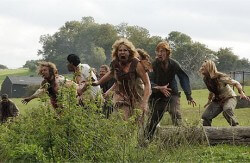
28 Days Later infected people
Notable qualities: Those who have become infected with a disease/virus making them seem zombie-like, but are not in the act of being dead prior to being in the act of being a zombie. While these are dangerous and contagious beings, they are not actually zombies.
See them in: example: 28 Days Later (2002), 28 Weeks Later (2007), The Crazies (2010)
Watch out for: The potential for abnormal strength, aggression, and/or irrational behavior. While they are not the undead, they may behave very similarly—and are much more likely to bleed on those they’re attacking.
It is important to draw a clear line between who is a zombie and who is not. Those who are acting like zombies but are still alive should be turned over to the Centers for Disease Control. However, it is best not to get close enough to check for vital signs unless the potential zombie is restrained and one is wearing biohazard level four gear.

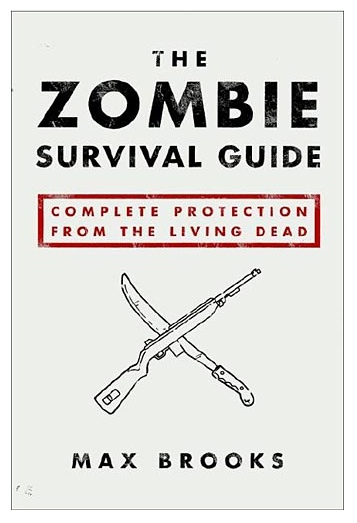

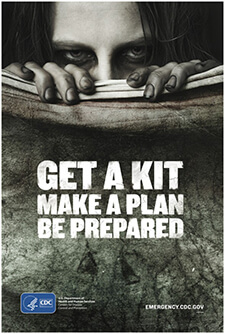
made it through the rartupe Saturday so I posted yet again about the zombie apocalypse, because it is obviously a very serious thing because the CDC is giving preparation instructions. I
Zombies cannot bring people who are already dead back to life. Biting a corpse will not create a new zombie. The infected can infect others, and they will. Either way, zombie or infected, you will have to kill it. Zombies and the infected also have no memory of their previous lives. I really doubt grandma is going to remember baking sugar cookies with you when she’s eating your face off